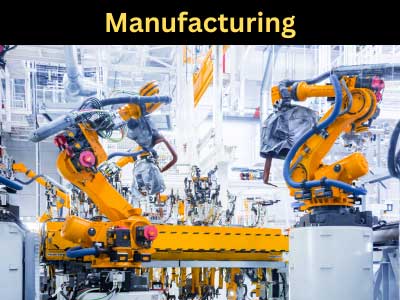Key Takeaway
Artificial intelligence (AI) plays a crucial role in predictive maintenance by analyzing historical equipment data to predict potential failures. By identifying patterns and early warning signs, AI enables proactive maintenance scheduling, reducing unplanned downtime and avoiding costly production interruptions.
AI-driven predictive maintenance not only improves equipment reliability but also extends the lifespan of machinery, leading to significant cost savings. However, implementing AI requires investment in technology and skilled personnel. Despite these challenges, the long-term benefits of reduced downtime, increased efficiency, and optimized maintenance schedules make AI an invaluable tool in modern manufacturing.
Defining Predictive Maintenance and AI’s Role
Predictive maintenance, often abbreviated as PdM, is a proactive maintenance strategy that uses real-time data, historical data, and machine learning models to predict when equipment might fail. The goal is to perform maintenance at the optimal time, just before a failure occurs, reducing unplanned downtime and costly repairs. Instead of relying on a fixed maintenance schedule or reacting to equipment failures, predictive maintenance ensures interventions are done only when necessary.
Artificial Intelligence (AI) plays a crucial role in predictive maintenance by analyzing large volumes of data to detect patterns and anomalies that human operators might miss. AI-powered systems can automatically flag potential issues before they escalate into major problems. By leveraging machine learning algorithms, AI continuously improves its accuracy in predicting equipment failures, making predictive maintenance a more efficient and reliable approach. The combination of AI and PdM can significantly improve the overall efficiency of operations, reduce costs, and enhance the lifespan of equipment.

How AI Analyzes Data for Predictive Maintenance
AI processes vast amounts of data from various sensors embedded in machines. These sensors continuously collect data on temperature, vibration, pressure, and other critical operating conditions. This data is then analyzed by AI algorithms that identify patterns that might indicate wear and tear, inefficiency, or impending failure. Machine learning models are trained to recognize these patterns, allowing the AI to make accurate predictions about when maintenance is needed.
For example, if a motor starts vibrating at an unusual frequency, AI can detect this anomaly and alert the maintenance team before the motor breaks down. AI-driven systems are particularly adept at handling complex, non-linear data, which is common in industrial settings. Traditional methods struggle with this type of data, but AI thrives, learning from past instances to predict future events with greater accuracy. This data-driven approach allows businesses to optimize their maintenance schedules, saving time and money while ensuring the longevity of their equipment.
Reducing Downtime with AI-Driven Maintenance
Unplanned downtime is one of the most expensive issues in industrial operations. When machinery breaks down unexpectedly, production halts, often leading to missed deadlines, lost revenue, and customer dissatisfaction. AI-driven predictive maintenance reduces downtime by accurately forecasting when equipment will fail, allowing maintenance to be scheduled during non-operational hours or planned downtime windows.
AI-driven systems are designed to alert operators to potential failures well in advance, enabling them to take action before a breakdown occurs. This preemptive maintenance minimizes disruptions and helps companies maintain a smooth flow of operations. Additionally, AI can prioritize maintenance tasks based on the severity of the predicted issue, ensuring that critical equipment receives immediate attention while less urgent matters can wait. By reducing the frequency and duration of downtime, AI-powered maintenance not only saves costs but also improves the overall productivity of an industrial operation.
The Benefits of AI-Powered Predictive Models
The use of AI in predictive maintenance brings several benefits to industrial environments. One of the primary advantages is the reduction in maintenance costs. Because maintenance is performed only when necessary, there’s no wasted effort or expenditure on unnecessary repairs. AI-powered models continuously analyze equipment data, meaning that operators are always informed about the current state of their machinery.
Another benefit is improved safety. AI can predict failures that might pose a risk to worker safety, such as high-pressure leaks or electrical malfunctions, ensuring that these issues are addressed before accidents happen. Furthermore, AI can extend the lifespan of equipment by preventing minor issues from escalating into major problems. When equipment runs smoothly without frequent breakdowns, its operational life increases, providing more value over time. Lastly, AI helps optimize inventory management by predicting which parts are most likely to need replacement, allowing companies to stock only the necessary components and avoid excess inventory.
Real-World Examples of AI in Predictive Maintenance
Many industries have already adopted AI for predictive maintenance with outstanding results. For example, in the aviation industry, companies use AI to monitor aircraft engines. AI-powered models analyze engine data, such as temperature and pressure, to predict when components will need to be replaced or serviced, thereby avoiding mid-flight failures. This approach improves safety while reducing costly delays due to unexpected repairs.
Similarly, in the automotive manufacturing sector, AI is used to monitor the health of assembly line robots. These robots are vital for production, and any downtime can disrupt the entire supply chain. By implementing AI-based predictive maintenance, manufacturers can detect issues in advance, schedule repairs, and maintain continuous operations without interruption. The success of these examples demonstrates how AI is revolutionizing industries by providing reliable, data-driven insights for equipment maintenance.
Conclusion
The integration of AI into predictive maintenance is not only a game-changer for current industrial operations but also a glimpse into the future of how industries will function. As AI technologies evolve, predictive models will become even more precise and adaptive, capable of handling more complex equipment and larger datasets. This evolution will lead to further improvements in operational efficiency, safety, and cost savings.
AI-powered predictive maintenance will also extend beyond individual machines to entire systems and networks, providing a holistic view of industrial operations. With AI continuously learning and adapting, companies will be able to rely on these systems to make critical maintenance decisions autonomously. As more businesses embrace AI-driven solutions, predictive maintenance will likely become the industry standard, transforming how maintenance is approached in every sector.
